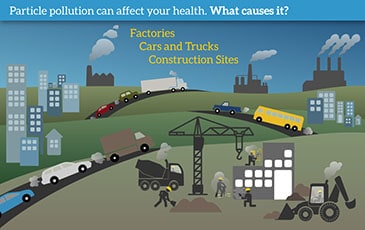Particle Pollution

Particle pollution — also called particulate matter (PM) — is made up of particles (tiny pieces) of solids or liquids that are in the air. These particles may include:
- Dust
- Dirt
- Soot
- Smoke
- Drops of liquid
Some particles are big enough (or appear dark enough) to see — for example, you can often see smoke in the air. Others are so small that you can’t see them in the air.
Where does particle pollution come from?
Particle pollution can come from two different kinds of sources — primary or secondary. Primary sources cause particle pollution on their own. For example, wood stoves and forest fires are primary sources.
Secondary sources let off gases that can form particles. Power plants and coal fires are examples of secondary sources. Some other common sources of particle pollution can be either primary or secondary — for example, factories, cars and trucks, and construction sites.
Smoke from fires and emissions (releases) from power plants, industrial facilities, and cars and trucks contain PM2.5.
Particle Pollution and Your Health
Breathing in particle pollution can be harmful to your health. Coarse (bigger) particles, called PM10, can irritate your eyes, nose, and throat. Dust from roads, farms, dry riverbeds, construction sites, and mines are types of PM10.
Fine (smaller) particles, called PM2.5, are more dangerous because they can get into the deep parts of your lungs — or even into your blood.
How can particle pollution affect my health?
Particle pollution can affect anyone, but it bothers some people more than others. People most likely to experience health effects caused by particle pollution include:
- People with heart or lung diseases (for example, asthma)
- Older adults
- Babies and children
Read more about the health impacts of PM.
If you have asthma, particle pollution can make your symptoms worse. Carefully follow your asthma management plan on days when pollution levels are high.
Particle pollution has also been linked to:
- Eye irritation
- Lung and throat irritation
- Trouble breathing
- Lung cancer
- Problems with babies at birth (for example, low birth weight)
Heart Disease
If you have heart disease, breathing in particle pollution can cause serious problems like a heart attack. Symptoms include:
- Chest pain or tightness
- Fast heartbeat
- Feeling out of breath
- Being more tired than usual
If you have any of these signs, contact your doctor. Be sure to let your doctor know if the symptoms get worse or last longer than usual.
Protect Yourself and Your Family
The good news is there’s a lot you can do to protect yourself and your family from the health effects caused by particle pollution. Start by learning about the Air Quality Index.
Air Quality Index (AQI)
The Air Quality Index (AQI) tells you when air pollution is likely to reach levels that could be harmful. You can use the AQI as a tool to help you avoid particle pollution. Local TV stations, radio programs, and newspapers report the AQI. Try checking it when you’re planning your daily activities.
Take Action
When particle pollution levels are high, take steps to limit the amount of air you breathe in while you’re outside. For example:
- Think about spending more time indoors, where particle pollution levels are usually lower.
- Choose easier outdoor activities (like walking instead of running) so you don’t breathe as hard.
- Avoid busy roads and highways where PM is usually worse because of emissions from cars and trucks.
For more tools to help you learn about air quality, visit Tracking Air Quality.